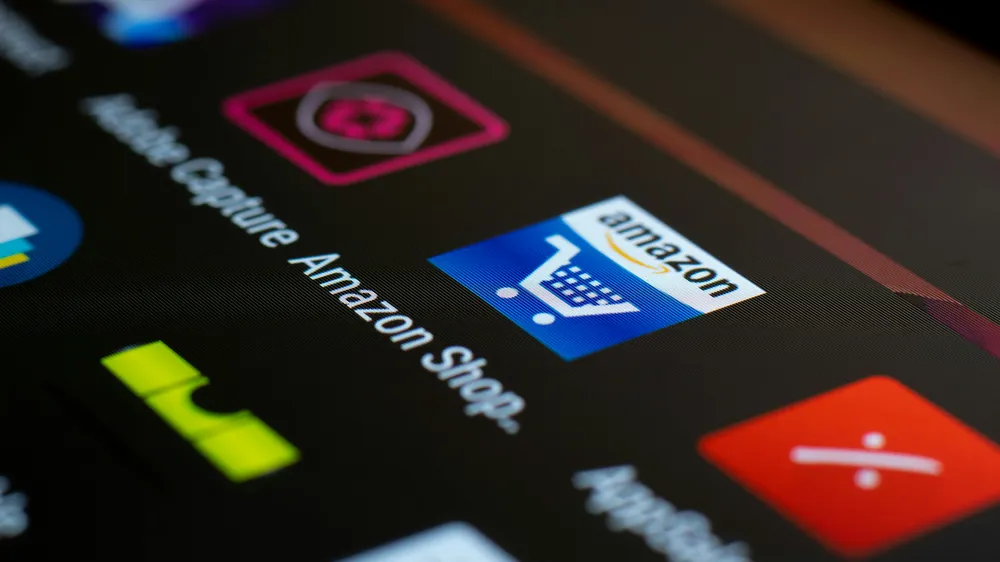
What Is Amazon Vendor? Complete Guide to Amazon's First-Party Selling Program
Table of Contents
Amazon Vendor is Amazon’s invitation-only, first-party (1P) selling program where manufacturers and brands sell their products directly to Amazon—rather than to customers. As a vendor, you essentially become Amazon’s supplier; they purchase your inventory wholesale, then list and sell your products under the “Ships from and sold by Amazon” label. This wholesale relationship fundamentally differs from the third-party (3P) seller model, where you maintain ownership of your inventory and sell directly to customers through Amazon’s marketplace.
For businesses weighing their Amazon strategy options, understanding the vendor program is crucial. It offers distinct advantages in brand presentation, Prime eligibility, and operational simplicity—but comes with significant trade-offs in pricing control, profit margins, and payment terms.
What Is an Amazon Vendor?
An Amazon Vendor operates under a wholesale business model with Amazon. You sell your products in bulk directly to Amazon, who then becomes the retailer of your products to end customers. This first-party relationship means Amazon takes full ownership of your inventory, controls pricing, manages customer service, and handles all aspects of order fulfillment.
The vendor relationship is managed through Amazon Vendor Central—a portal distinct from the more widely accessible Seller Central platform. Through Vendor Central, you’ll receive purchase orders from Amazon, manage your product catalogue, access analytics, and handle various operational aspects of your wholesale relationship.
The key distinction of the vendor model appears on the customer-facing side: your products display as “Ships from and sold by Amazon,” lending them the full weight of Amazon’s trusted brand. This official Amazon endorsement can significantly boost consumer confidence in your products.
Unlike Amazon’s seller program which is open to virtually any business, the vendor program operates on an invitation-only basis. Amazon typically extends these invitations to established brands and manufacturers with proven sales records, strong production capacity, and products that align with Amazon’s retail strategy.
Amazon Vendor Central vs. Amazon Seller Central: Key Differences
Understanding the fundamental differences between these two business models is essential for making the right strategic choice for your business.
Relationship Structure
| Aspect | Amazon Vendor (1P) | Amazon Seller (3P) |
|---|---|---|
| Business Model | Wholesale supplier to Amazon | Independent retailer on Amazon |
| Inventory Ownership | Amazon owns inventory after purchase | Seller maintains ownership of inventory |
| Pricing Control | Amazon sets retail prices | Seller controls product pricing |
| Customer Relationship | Amazon owns the customer relationship | Seller has limited customer interaction |
| Brand Presentation | “Ships from and sold by Amazon” | “Sold by [Your Business], Fulfilled by Amazon” (if using FBA) |
The relationship structure fundamentally shapes how you’ll operate on Amazon. As a vendor, you’re essentially a supplier in a B2B relationship with Amazon. As a seller, you’re a retailer using Amazon as your sales channel while maintaining greater independence.
Business Operations
The operational differences between vendor and seller models are substantial and impact your daily business activities significantly.
When you’re a vendor, Amazon sends purchase orders based on their inventory needs and sales forecasts. You fulfil these orders by shipping to Amazon’s distribution centres according to their strict requirements. The process is more akin to traditional wholesale, with the added complexity of Amazon’s exacting standards.
In contrast, as a seller, you list products, set inventory levels, and fulfil orders either through Fulfilled by Amazon (FBA) or your own shipping operation (Fulfilled by Merchant). This gives you greater flexibility but requires more active management.
Inventory management as a vendor can be particularly challenging. Amazon’s ordering patterns may be inconsistent, sometimes leaving you with excess inventory or scrambling to meet large orders. Their forecasting isn’t always aligned with your production capabilities, and you have limited control over these decisions.
Payment structures differ dramatically as well. Vendors typically wait 30-90 days for payment after Amazon receives inventory, while sellers receive payments approximately every two weeks for completed sales. This payment timing can have profound implications for your cash flow.
Detailed Benefits of Being an Amazon Vendor
The vendor model offers several compelling advantages that make it attractive to many brands:
Amazon’s Trusted Brand Association
Perhaps the most significant benefit is the “Ships from and sold by Amazon” badge on your listings. This official Amazon endorsement lends credibility to your products and can boost conversion rates, particularly for new or lesser-known brands. Customers often perceive these products as more trustworthy and are more willing to purchase without extensive research or social proof.
Automatic Prime Eligibility
All vendor products automatically qualify for Amazon Prime, giving you access to Amazon’s most valuable customer segment without additional qualification requirements. Prime members spend substantially more on Amazon than non-Prime customers and are more likely to make repeat purchases.
Enhanced Marketing and Promotional Opportunities
Vendors gain access to exclusive marketing programs not available to third-party sellers. These include:
- Amazon Vine program for generating trusted reviews
- Enhanced A+ Content with more interactive features
- Participation in Amazon’s deal events with potentially better placement
- Access to Amazon Marketing Services with potentially better ad placements
Operational Simplicity
The vendor model simplifies certain aspects of selling on Amazon. You don’t need to manage individual customer orders, handle customer service inquiries, or deal with returns processing. Your primary focus becomes fulfilling Amazon’s purchase orders and maintaining product quality. This operational simplicity can be particularly valuable for brands that prefer to focus on product development and manufacturing rather than retail operations.
Challenges and Drawbacks of the Amazon Vendor Model
Despite its advantages, the vendor model comes with significant challenges that every brand should carefully consider:
Loss of Pricing Control
Perhaps the most significant drawback is surrendering pricing control to Amazon. Their algorithm-driven pricing strategy aims to maximize Amazon’s competitiveness and revenue—not necessarily your profit margins. Amazon may discount your products heavily during competitive periods or raise prices when they deem appropriate, all without your input or approval.
This loss of control can lead to several problems:
- Erosion of your brand’s perceived value through excessive discounting
- Channel conflict with other retailers carrying your products
- Inconsistent pricing that confuses customers
- Potential MAP (Minimum Advertised Price) violations affecting other retail relationships
Lower Profit Margins
The wholesale nature of the vendor relationship typically results in lower profit margins compared to the seller model. Amazon expects significant wholesale discounts—often 20-40% off retail prices—and may negotiate aggressively, particularly as your sales volume increases.
These margin pressures are further compounded by:
- Chargebacks for non-compliance with logistics requirements
- Co-op advertising fees and marketing contributions
- Long payment terms affecting cash flow
- Potential for returns and unsold inventory deductions
Strict Logistical Requirements
Amazon imposes exacting standards for product delivery, packaging, and labelling. Failure to meet these requirements results in chargebacks—fees deducted from your payments. These requirements include:
- Specific delivery appointment windows
- Precise pallet configurations
- Strict carton and product labelling
- EDI (Electronic Data Interchange) compliance
- Packaging that meets Amazon’s frustration-free standards
For many vendors, these chargebacks become a significant expense, sometimes reaching 10-20% of their Amazon revenue.
Limited Customer Data Access
As a vendor, you lose direct access to customer information. You won’t know who’s purchasing your products, their buying patterns, or have the ability to build direct relationships with your end users. This data limitation hampers your ability to:
- Develop targeted marketing strategies
- Understand customer demographics
- Build direct customer relationships
- Cross-sell or up-sell to existing customers
- Gather direct feedback for product improvement
Amazon Vendor Requirements and Application Process
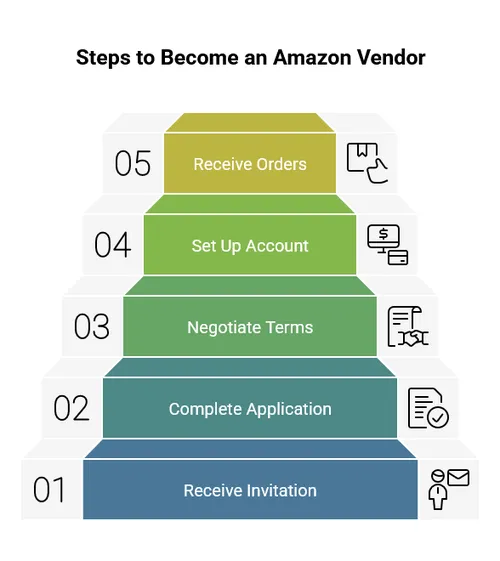
Unlike the seller program, which is open to virtually any business, the vendor program operates primarily by invitation. Amazon typically extends these invitations to established brands and manufacturers that meet certain criteria.
While there’s no guaranteed path to receiving an invitation, businesses that typically attract Amazon’s interest share several characteristics:
- Established brand presence with proven sales history
- Strong production capacity and reliable supply chain
- Products with consistent customer demand
- Competitive wholesale pricing
- Professional packaging and product presentation
- Compliance with industry regulations and standards
If you haven’t received an invitation but are interested in the vendor program, you can express interest through Amazon’s Vendor Express program (though availability varies by region) or by contacting Amazon’s retail team through business development channels.
The application process typically involves:
- Receiving an invitation or expressing interest
- Completing a detailed application with business information
- Providing product specifications, pricing, and availability details
- Negotiating terms and conditions
- Setting up your Vendor Central account
- Completing onboarding and training
During negotiations, pay particular attention to payment terms, return allowances, and marketing contribution requirements. These factors significantly impact your profitability as a vendor.
Amazon Vendor Tools and Resources
Amazon provides vendors with several specialized tools through the Vendor Central portal:
Retail Analytics
Vendor Central offers detailed analytics on your product performance, including:
- Sales trends and velocity
- Inventory levels and forecasts
- Return rates and reasons
- Customer review metrics
- Search performance indicators
While not as comprehensive as the data available to sellers, these analytics provide valuable insights for optimising your vendor strategy.
A+ Content Creation
Vendors can create enhanced product descriptions known as A+ Content (formerly Enhanced Brand Content). This feature allows you to:
- Add rich text and images to product descriptions
- Include comparison charts and feature highlights
- Tell your brand story more effectively
- Showcase product benefits visually
- Potentially access more advanced modules than sellers
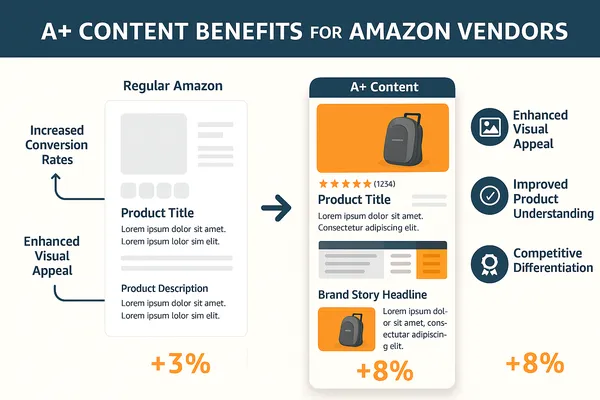
Amazon Vine Program
The Vine program gives vendors access to Amazon’s most trusted reviewers. These reviewers receive your products for free and provide detailed, honest feedback. This program helps:
- Generate initial reviews for new products
- Obtain detailed, high-quality feedback
- Build social proof through verified reviews
- Improve product visibility in search results
Advertising Options
Vendors have access to several advertising options through Amazon Marketing Services (AMS):
- Sponsored Products: Keyword-targeted ads that appear in search results
- Sponsored Brands: Banner ads featuring your logo and multiple products
- Product Display Ads: Ads that appear on related product pages
- Amazon DSP: Programmatic display advertising across Amazon and partner sites
Many vendors report that their ads often receive preferential placement compared to similar seller ads, though Amazon doesn’t officially confirm this advantage.
Fulfillment Options for Amazon Vendors
As a vendor, you have two primary fulfillment models available:
Standard Vendor Fulfillment
Under the standard model, you receive purchase orders from Amazon and ship inventory to their distribution centres. Amazon then manages all aspects of storage, fulfillment, and customer delivery.
This model requires:
- Adherence to strict delivery schedules
- Compliance with Amazon’s packaging requirements
- Proper EDI integration for order processing
- Capacity to fulfil potentially large, irregular orders
Direct Fulfillment (Drop-Ship)
Some vendors qualify for Direct Fulfillment, Amazon’s dropship program. Under this model:
- Amazon lists and sells your products as normal
- When a customer orders, Amazon sends you the order details
- You ship directly to the customer using Amazon-branded packaging
- The customer experience remains “Sold by Amazon”
This model offers several advantages:
- Reduced inventory risk for both you and Amazon
- Ability to offer a broader product selection
- Lower likelihood of “out-of-stocks”
- Reduced shipping costs to Amazon warehouses
However, Direct Fulfillment requires sophisticated inventory management systems and the ability to ship individual orders quickly while maintaining Amazon’s delivery standards.
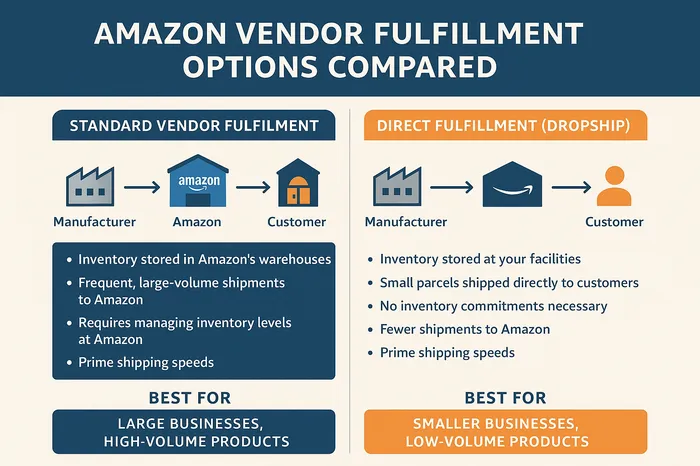
Hybrid Approach: When to Use Both Vendor and Seller Models
Many successful Amazon businesses leverage both vendor and seller relationships simultaneously—a strategy known as the hybrid model. This approach allows you to capitalize on the strengths of each program while mitigating their respective weaknesses.
Benefits of a Hybrid Strategy
A hybrid approach offers several strategic advantages:
- Diversified revenue streams that reduce dependency on a single Amazon relationship
- Greater inventory control by balancing wholesale and direct sales
- Price monitoring capabilities by maintaining visibility as a seller
- Expanded product range options by using each channel strategically
- Improved negotiating position with Amazon by having alternatives
Product Selection Considerations
Not all products are equally suited to both channels. Consider these factors when determining which products to sell through each model:
| Vendor Central (1P) Best For | Seller Central (3P) Best For |
|---|---|
| High-volume, established products | New product launches and tests |
| Items with stable demand | Seasonal or variable-demand items |
| Products with healthy wholesale margins | Higher-margin speciality products |
| Items that benefit from Amazon’s brand trust | Products requiring specialized knowledge |
| Products with minimal variation/complexity | Items with many variations or bundles |
Managing Potential Conflicts
Operating in both channels simultaneously requires careful management to avoid conflicts:
- Ensure consistent pricing strategy across both channels
- Maintain separate SKUs or product variations when possible
- Develop clear inventory allocation processes
- Create channel-specific promotional calendars
- Establish separate teams or team members for each channel
How to Choose Between Amazon Vendor and Seller
Deciding between vendor and seller models—or implementing a hybrid approach—requires careful consideration of your business priorities and capabilities.
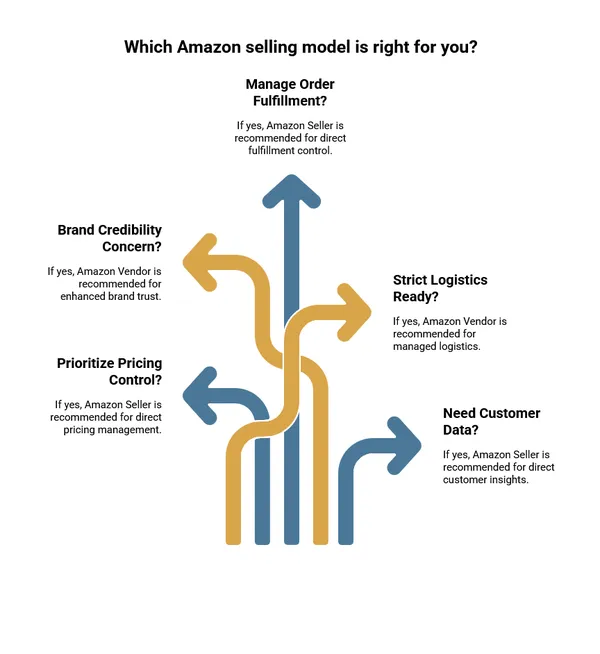
Business Model Alignment
Consider how each model aligns with your broader business strategy:
- Brand-focused businesses may benefit from the credibility of “Sold by Amazon”
- Margin-focused operations typically perform better in the seller program
- Manufacturing-oriented companies often prefer the simplicity of the vendor model
- Marketing-driven brands might leverage the seller program’s greater control
- Multi-channel retailers must consider how Amazon fits into their overall strategy
Financial Implications
The financial differences between models are substantial:
- Cash flow requirements: Vendors must manage longer payment terms (30-90 days)
- Margin expectations: Seller margins typically exceed vendor margins by 10-20%
- Marketing investments: Vendors often face higher co-op advertising requirements
- Operational costs: Sellers bear more fulfillment and customer service costs
- Chargeback risk: Vendors must account for potential compliance penalties
Control Priorities
Your desire for control in various aspects of your Amazon presence should heavily influence your decision:
- Pricing control: Sellers maintain complete pricing authority
- Inventory management: Sellers determine inventory levels and allocation
- Customer relationship: Sellers have more direct customer interaction
- Content and branding: Both have brand content tools, but with different capabilities
- Promotional timing: Sellers have more flexibility in promotional scheduling
Making the Transition: Seller to Vendor or Vendor to Seller
Many businesses find themselves transitioning between models as their Amazon strategy evolves. These transitions require careful planning and execution.
Seller to Vendor Transition
When moving from seller to vendor:
- Inventory planning becomes critical—prepare for the shift from continuous replenishment to purchase order cycles
- Pricing strategy must adapt to account for wholesale pricing and loss of retail price control
- Operational adjustments are needed to meet vendor logistics requirements
- Financial preparation is essential to manage longer payment terms
- Content migration should preserve your enhanced content and product information
Vendor to Seller Transition
When transitioning from vendor to seller:
- Account setup requires creating and configuring your Seller Central account
- Listing creation involves establishing new product listings (often alongside existing vendor listings)
- Inventory planning means preparing for direct fulfillment or FBA inventory placement
- Buy Box strategy becomes important as you may compete with Amazon on your own products
- Customer service capabilities must be developed to handle direct customer interactions

Future of Amazon Vendor Programs
Amazon’s approach to vendor relationships continues to evolve, with several notable trends shaping the future landscape:
Program Consolidation
Amazon has shown signs of consolidating its various selling programs. The rumoured “One Vendor” system would merge aspects of the 1P and 3P models, potentially creating a more unified approach to Amazon selling. This consolidation could simplify operations but may also reduce flexibility for brands.
Increased Automation
Vendor negotiations and terms are increasingly algorithm-driven rather than relationship-based. This shift means:
- More data-driven purchase order generation
- Automated price adjustments based on market conditions
- Algorithmic determination of promotional opportunities
- Less human interaction with vendor managers
- More standardised terms based on account performance metrics
Greater Emphasis on Profitability
Amazon has increasingly focused on vendor profitability, particularly for smaller brands. This emphasis manifests as:
- More aggressive wholesale price negotiations
- Reduced purchase volumes for lower-margin items
- Increased pressure for marketing contributions
- Higher standards for logistics compliance
- More frequent review of vendor performance metrics
Selective Invitation Strategy
The vendor program is becoming increasingly selective, with Amazon focusing on:
- Established brands with proven market demand
- Products with strong profitability potential
- Categories aligned with Amazon’s strategic priorities
- Vendors with sophisticated supply chain capabilities
- Brands willing to invest in Amazon-specific marketing
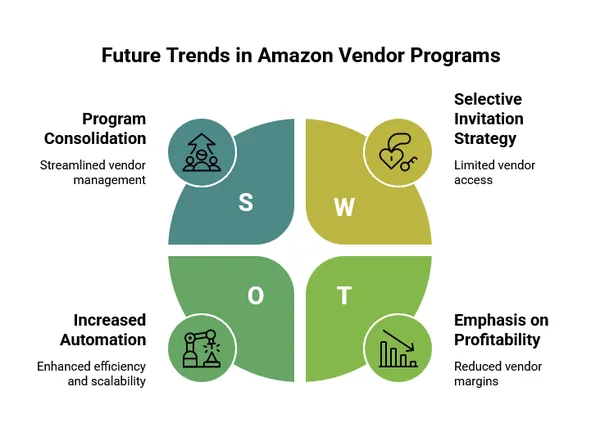
Conclusion
The Amazon Vendor program offers a distinctive approach to selling on the world’s largest e-commerce platform. For the right businesses—particularly established brands with strong production capacity and healthy wholesale margins—it provides valuable benefits in brand presentation, operational simplicity, and access to Amazon’s most loyal customers.
However, these advantages come with significant trade-offs in pricing control, profit margins, and business autonomy. The decision between vendor and seller models—or a strategic hybrid approach—should be based on a careful assessment of your business priorities, capabilities, and long-term Amazon strategy.
Whichever path you choose, success on Amazon requires continuous adaptation to the platform’s evolving requirements and opportunities. By understanding the fundamental differences between these business models, you can make informed decisions that position your brand for sustainable growth in the Amazon ecosystem.
FAQs About Amazon Vendor Program
Is Amazon Vendor invitation-only?
Yes, the standard Amazon Vendor program operates on an invitation-only basis. Amazon typically invites established brands and manufacturers with proven sales history, strong production capacity, and products that align with their retail strategy. While you can express interest through certain channels, Amazon makes the final determination on vendor relationships.
What are the typical payment terms for Amazon Vendors?
Standard payment terms for Amazon Vendors range from 30 to 90 days after Amazon receives your inventory. Larger vendors with significant negotiating leverage may secure more favourable terms, while smaller vendors typically face longer payment windows. These extended terms can create cash flow challenges, particularly for smaller businesses.
Can I negotiate better terms as an Amazon Vendor?
Some aspects of the vendor relationship are negotiable, particularly for larger brands with significant sales potential or unique products. Negotiable elements may include:
- Payment terms (though Amazon is typically firm on these)
- Marketing contribution requirements
- Return allowances and policies
- Freight terms and shipping arrangements
- Promotional calendar and discount expectations
Your negotiating leverage typically depends on your brand strength, product uniqueness, and sales potential.
How do Amazon Vendor chargebacks work?
Chargebacks are fees Amazon deducts from vendor payments for non-compliance with their requirements. Common chargeback reasons include:
- Late deliveries or missed appointment windows
- Incorrect product labelling or packaging
- Damaged products or quality issues
- Missing or incorrect EDI (Electronic Data Interchange) information
- Failure to meet packaging or preparation requirements
These chargebacks can significantly impact profitability, sometimes reaching 10-20% of revenue for vendors struggling with compliance.
What happens if Amazon stops ordering my products?
Unlike the seller model where you control inventory levels, as a vendor, you’re dependent on Amazon’s purchase orders. If Amazon stops ordering:
- You have limited recourse to force additional orders
- Your products may show as out of stock on Amazon
- You may need to transition to the seller model to maintain availability
- You can attempt to engage with your vendor manager, but decisions are often algorithm-driven
- You should diversify to other sales channels to reduce dependency
This vulnerability to Amazon’s ordering patterns represents one of the most significant risks of the vendor model.
How does the Amazon Vine program work for vendors?
The Amazon Vine program gives vendors access to Amazon’s most trusted reviewers (called “Vine Voices”). As a vendor, you can enrol eligible products and provide free units to these reviewers. They’ll test your products and provide honest, detailed reviews that are marked with a “Vine Voice” badge. This program helps new products gain initial reviews, which are crucial for conversion rates. While there’s a fee to participate, many vendors find the investment worthwhile for building social proof quickly.
Can I access customer data as an Amazon Vendor?
As a vendor, you have limited access to customer data compared to sellers. You won’t receive individual customer information such as names, email addresses, or detailed purchase history. Instead, you’ll have access to aggregated data through Vendor Central analytics, including sales trends, conversion rates, and review metrics. This limitation makes it difficult to build direct customer relationships or conduct targeted marketing outside the Amazon ecosystem—a significant consideration for brands focused on customer lifetime value.